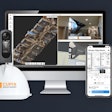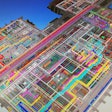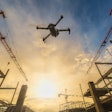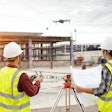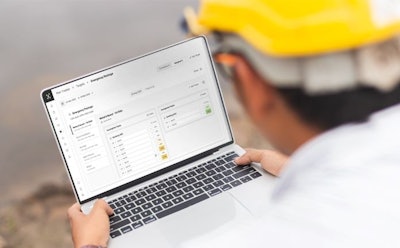
Tel Aviv-based construction photogrammetry vendor Buildots has announced a new suite of tools that enable construction teams to plan and track weekly activities and milestones using project-specific data.
The new Plan Tracker functionality includes two essential tools that extend their existing application set:
- Workplan, which allows project managers to break down project plans into smaller tasks, set realistic due dates for each, share the plan with the respective trades, compare actual progress against plans, and use the system-provided feedback to continuously improve performance.
- Targets, which enables teams to set critical milestones in the system and accurately track progress against these goals, including subcontractor performance and supply chain issues. Users can add new operational and contractual targets, assign related tasks and activities, and set due dates in one place. This functionality helps to easily identify issues early on and take corrective measures to protect these milestones, preventing work stoppages and delays, while fostering accountability within the team and with subcontractors.
READ THE IRONPROS PHOTOGRAMMETRY WIKI
The Plan Tracker is built around lean construction methods, which improves accountability with teams and subcontractors, minimizing waste and maximizing value delivered. But the Buildots offering overall aims to use 360-degree photos to populate and update a digital twin of the asset. According to Buildots Director of Product Management Amir Berman, the product is more robust, too, in its ability to track progress, up to and including supporting application for payment, than rivals.
“Our competitors have a strong foundation with reality capturing, and only then added progress tracking on top of that, which is like a major challenge,” Berman said. “For us, it was built out starting from day one, with a mission to eliminate subjective data collection. We started from day one with the technology part that allows us to collect data at scale and analyze the progress of various data on various construction projects, no matter the type, no matter the vertical, no matter the geography or the size of the project. You just need to go with a camera, and we're able to pick up 90 to 95% of your job site very easily. So the technology part, we believe, is a major blocker for different players in this market. And we kind of dealt with this first. We feel very, very comfortable and we have the evidence to back it up. We're adding new capabilities, which makes data more tangible at the job sites, and for team members. We feel that we have a very strong advantage.”
According to Berman, Buildots has strong market uptake of their tracking features, to the point where it is being used by customers to support application for payment.
“A lot of our clients are using Buildots to verify payments and to automate the payment process,” Berman said. “We take it all the way to what can be claimed by your subcontractors when they ask you to pay a certain amount of money. These claims are often today based on an Excel sheet. Buildots is automatically telling our clients, well, this was actually completed, but that wasn't completed so we don't need to pay for that.”
4D Vision
Buildots is built around a 4D model that takes a 3D representation of the project and layers on time as an additional dimension. This means the software must start with the 3D plan and discrete project milestones, which Buildots acquires through integrations with the project design and schedule. This data can then be compared and contrasted with actual progress against those milestones as revealed in 360 imagery.
“In order for us to compare the status of the project, or any kind of construction project between reality and your plans, we need to obtain your plans correctly,” Berman said. “So we invested a lot in integrating with tools like Navisworks, Revit, and the various scheduling software. We not only integrated with them, but we can extract both design data and schedule data into our own proprietary data model, which is kind of construction-specific. This data model represents your project as a digital twin—the architecture, the layout, the building structure, the different subcontractors, activity duration, the milestones, everything that that's important that you invested in during pre-construction.”
A contractor may need to monitor progression of ductwork on a project for instance, and Buildots’ machine vision algorithms will extrapolate from 360 photos linear feed of ductwork completed, determining if that part of the project is on track or falling behind. What’s more, Buildots will proactively communicate when the schedule is at risk.
“The software will calculate if there's any risk at your job right now that you need to fix, whether it's specific activities, specific trades or specific area in the building,” Berman said. “With most of our clients, we are identifying pace, continuity, throughput and consistency. We can monitor return visits, and a lot of more tangible metrics that we're working with our clients to make sure they not only get progress data, but are optimizing their project performance.”
The application standardizes on GoPro Max 360-degree cameras. Other recent product releases from Buildots include an app that enables access to walk-through data without mobile connectivity.
Buildots Tech Stack
At the tip of the spear, Buildots standardizes on GoPro Max 360-degree cameras. The application itself can ingest other data sources, and according to Berman this can be done without an additional spend on professional services.
The cloud application is provisioned on AWS, with new product shipped about monthly.
Buildots Pricing and Market
Buildots is targeted primarily at vertical contractors as opposed to civil or heavy highway, and currently at the higher side of the market in terms of annualized construction revenue.
Contractors become a fit for Buildots once they reach about $250 million in revenue per year. Involvement in specific, demanding, project types multifamily residential, commercial spaces, healthcare, airports, complex fabrication and data centers also make it more likely a contractor will see the hard return on investment from Buildots.
Pricing is determined by the number of square feet for a given project, as this will equate roughly to the compute resource necessary in AWS. The complexity of the project also becomes a factor in pricing, according to Berman.
While in some cases, contractors use Buildots on a specific project, as their footprint grows they can become eligible for a cool person discount through enterprise pricing.
“On the first project or two, we're going to be project by project,” Berman said, while stressing the discount will depend on factors over and above the number of projects. “From our experience with our clientsafter the first and second project, they will make us a default provider for that specific vertical or region. But every customer is a cool customer. The discount depends on the volume, the future projects you may have. There's no like magic number. But I would say that that we encourage our clients to have us as a default because we see them then a lifetime partner, and they see us as a lifetime provider. So we want to get into that default agreement with you at some point.”
BOTTOM LINE: Based in Tel Aviv, Buildots is according to Berman prioritizing the North American market, which means established vendors like San Francisco-based Openspace may start seeing them more in deals on this side of the pond. Contractors evaluating these two may want to ask for press each vendor for more and more detailed demos of progress tracking features to judge for themselves which vendor is further along at any given time or how well each supports a contractors' business model. But as the documentation, process automation and dispute resolution capabilities of photogrammetry combined with machine vision become more and more in demand by owners, generals and subs alike, there's room for multiple strong vendors including broad market leaders and more specialized or progressive startups.





